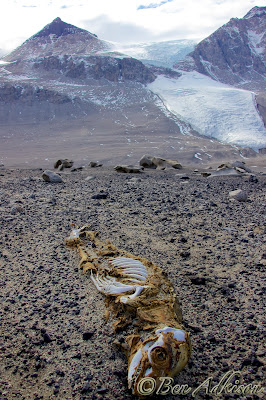It’s not that that Antarctica doesn’t have any
mountains. I get to look at amazing
mountains every day. That is just the
problem though: I only get to look at them.
Working 6 days a week doesn’t leave any time to even consider climbing a
mountain. There is also no way to get to
mountains for non-work related purposes.
 |
| Erebus Glacier tongue from the air |
A few days up on Mt. Erebus helped to remind me why I
started working on mountains. It made me
think of everything that has happened during the past few years that has
allowed me to work down here—to be sitting at 11,000ft on the side of an active
volcano in Antarctica overlooking the ocean.
 |
| Western slopes of Mt. Erebus |
There were the all too familiar moments sitting on a high,
cold mountain looking out across a vast (somewhat) blank landscape and
wondering what the hell I’m doing sitting there and all the events that had to
fall into place perfectly [or accidently or all together failed] for me to be
there at that moment. Some of the times
I have felt most alive are the times when I am freezing on the side or top of a
mountain a mountain—it could just be the lack of oxygen making me think
that.
 |
| Mt. Terror from the side of Mt. Erebus |
Now that I’ve signed a contract here to be down in
Antarctica for a full year, there will be months where I won’t even see a
mountain. They will only be images in my
dreams and daydreams—even though my daydreams will still happen in the dark.
 |
| Those dots in the center are our tents. |
Sometimes when I’m in the field for long periods of time I
feel like I’m missing out on so many things.
But really I’m not missing out on anything. There are few places I’d rather be. Most of the time when I’m back in town I’m
wishing I was in the mountains. I’ll be
missing out on the mountains for quite awhile by being down here.
 |
| McMurdo Sound and the Royal Society Range |
 |
| Sampling Gases in one of the ice caves on Mt Erebus |
My few days on Erebus and those feelings and views will have
to hold me over for many more months. In
the next few weeks I’ll be going much higher in altitude (up to 13,300ft) on
the Antarctic Plateau, but it will just about the flattest and whitest place on
earth.
 |
| More gas sampling |
As the sun gets lower in the sky each day; moving closer to
our next sunset that is still almost two months away, I am appreciating every
moment of sunshine that I can get my hands on.
 |
| Stormy day at the Erebus Hut |






























.jpg)
.jpg)
.jpg)